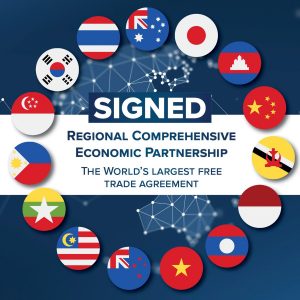RCEP | A SUPER FREE TRADE AGREEMENT
1. What is RCEP?
The Regional Comprehensive Economic Partnership, known as “RCEP”, is a free trade agreement (“FTA”) involving 15 countries in the Asia-Pacific region which are ASEAN members and ASEAN’s 05 FTA partners including Australia, China, Japan, Republic of Korea, and New Zealand (India had joined initial rounds of negotiation but withdrew in 2019). After 08 years of negotiation, the RCEP was signed on November 15, 2020 by 15 member countries. According to the final provisions of the FTA, it is open for India’s accession, and its entry into force would be 60 days after at least six ASEAN and three non-ASEAN signatory countries act on their ratification, acceptance or approval for the RCEP.

There are four key objectives of the RCEP agreement in creating an international economic partnership which are modern, comprehensive, high-quality and mutually beneficial. It is committed to support an open, inclusive, and rules-based multilateral trading system in order to expand regional trade and investment and contribute to global economic growth.
2. Some remarks about impacts of the RCEP
The RCEP has created the world’s largest trading bloc, with the GDP scale up to 30% of total global GDP (equivalent to USD 25,000 billion). The RCEP has formed the largest FTA in the world and is expected to effectively promote trade and economic growth in the region.
The Comprehensive and Progressive Agreement for Trans-Pacific Partnership (CPTPP), EU-Vietnam Free Trade Agreement (EVFTA) and the RCEP are not mutually exclusive, because Vietnam will gain many benefits from the co-existence of these agreements. Although the RCEP is not equal to CPTPP and EVFTA in the level of tariffs elimination and inclusiveness, it will still open up opportunities for Vietnam to gain benefits from countries with relatively high tariff barriers. Also, Vietnamese manufacturers can take advantage of preferences in rules of origin and can join deeper into the regional supply chain.
Generally, the contents of the RCEP include agreements on trade in goods, trade in services, investment, economic and technical cooperation, intellectual property, competition, e-commerce, SMEs, dispute settlement and other matters such as simplification of customs procedures, rules of origin for goods to facilitate trade. At the same time, the RCEP is committed to provide fair regional economic policies that mutually benefit both ASEAN and its FTA partners. Vietnamese enterprises, and enterprises of the RCEP’s member countries in general, will join the regional production and value chain network, while also receiving the benefit from the reduction of transaction costs and business-friendly environment through the harmonization of current rules in different ASEAN FTAs.










